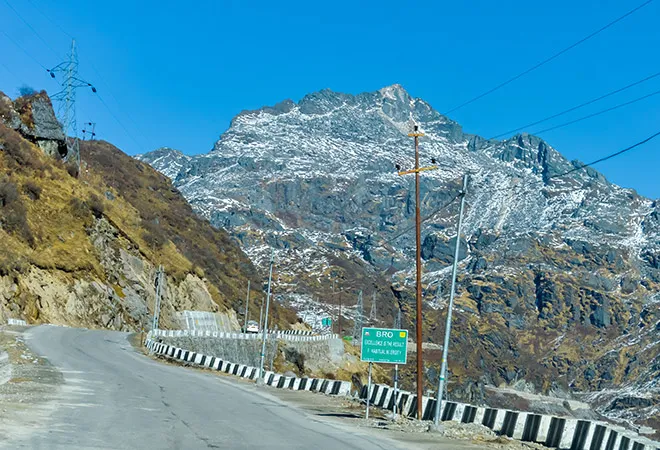
The Northeastern Region (NER) in India, comprising eight states, are often identified as having been relegated to the fringes of infrastructural and economic development. Despite policies such as the erstwhile Look East and its current refurbished version, Act East, the region has remained impaired. The developmental prospects of the NER have been further compounded by cross border as well as internal insurgencies. Nonetheless, as the resource and labour potential of the region together with its strategic geographical location proximate to Southeast Asia and a rapidly evolving Indo-Pacific, the NER has resurfaced as a zone of domestic priority as well as international cooperation. The NER is not only a crucial driver of India’s Act East Policy but can also serve as an impetus for enhancing India’s partnerships to both the West and the East.
In keeping with the larger regional goals of integration and development under the Act East Policy, it is very important to create local stake for the sustenance of the same over a long period of time. This would not only lend a sufficient degree of strength to the Act East initiative, but also address the vital criticism of failing to engage a region and its people who are otherwise critical to the success of this age-old policy that is much behind schedule. Doing this would enable mutually supporting structures that would sustain and spur the agenda of India’s engagement with Southeast Asia on the one hand and on the other, the development of the NER as a whole in the process.
The NER is not only a crucial driver of India’s Act East Policy but can also serve as an impetus for enhancing India’s partnerships to both the West and the East.
While instruments for facilitating the country’s links with the east of the continent are already in various stages of implementation, it is the other part of this drive that needs to be looked into. The latter entails the effective mitigation of security concerns alongside the creation of opportunities for investment. It is a known fact that one of the major impediments for development in the NER is its external and internal security concerns. While China plays a pivotal role in the India’s border tensions in this region, the internal security concerns include: Extremist and insurgency groups that have international links in escaping security forces, using of hideouts in neighboring countries like Myanmar, and the alleged presence of international intelligence agencies like ISI that operate in the NER. Although efforts have been deployed by the central and state governments, albeit intermittently and with varying degrees of success towards addressing both these requirements, cooperation with other countries for the same has significant scope as well, especially in the backdrop of foreign policy outreach geared towards the Indo-Pacific.
The Northeastern states are economically important for investment mainly on two fronts—firstly, the strategic location of the region that connects the product markets between the larger Indian geography along with the robust South and Southeast Asian markets, and secondly, the existence of potent input market catalysts such as social (diversity, cultural richness), physical (potential energy supply hubs), human (inexpensive, skilled labour) and natural (minerals, forests) capitals in the region. Hence, in the post-pandemic world, leveraging these factors could play an important role in the growing partnership and presence of countries like Japan, Australia, and Israel in the region.
Japan has been engaged for decades in the development and modernisation of infrastructure, particularly road connectivity, across states in the region and is presently involved in the construction of the Dhubri-Phulbari bridge across the Brahmaputra river in Assam. Many of the infrastructure projects undertaken by the Japan International Cooperation Agency (JICA) also cover areas like land and water resource development and management for sustainable agriculture and are designed to be inclusive through endeavours facilitating women's participation into the planning and implementation process. The deep and long involvement of Japan in the NER is also often attributed to cultural similarities which can be found manifested from the region’s architecture to fashion. In recent years, the NER has assumed greater importance from policy convergences between Japan’s Free and Open Indo-Pacific and India’s Act East which are being translated into on ground partnerships for quality infrastructure.
The deep and long involvement of Japan in the NER is also often attributed to cultural similarities which can be found manifested from the region’s architecture to fashion.
The creation of resilient value chains, facilitating trade, and further developing connectivity infrastructure in the NER comprise potential aspects of cooperation identified by Australia along with the possibility of a tripartite collaboration between India-Japan-Australia for enhancing connectivity links between the NER and the Indo-Pacific region.
India is also a 'focus' country for the Israeli government’s rising trade efforts. Being a leader in technology, Israel has expressed interest in sharing its technical best practices with the Indian government agencies and businesses, in fields ranging from development of smart cities to maintenance of physical infrastructure using real-time cloud-based technology. Needless to say, such efforts will be essential in the holistic development of the NER. Additionally, India along with Israel and the US are looking to collaborate on 5G technologies in India that will also help to boost the digital connectivity of the NER which would undoubtedly open a range of opportunities for services and jobs.
The drawbacks of remaining a transit route are illustrated, for instance, by the fact that the region is flooded with shops full of electronic and other consumer goods, mostly of Chinese make. This is not surprising since goods from China and other Southeast Asian nations find their way quite easily into India through the porous and largely unmanned border between India and Myanmar. Locals refer to these goods that enter from Myanmar into India as ‘Burmathil’ which translates as ‘goods from Burma’, no matter where the goods may have originated. Prima facie, there is no problem with this but it becomes a contentious issue since the volume of legal trade is meagre compared to that of informal trade and it estimates suggest that the informal border trade benefits Myanmar greatly as most of the profits are directed in favour of the latter; and also because local produce and manufacturing go unattended.
While domestic efforts will continue, the involvement of other countries in the development process of the NER is poised to secure multiple benefits.
In a scenario where states in the NER are left to continue as they have for so many years, the region will amount to either little more than being a transit route for the import and export taking place through the border points or a contentious extraction point for oil. Concerns of the large volume of informal trade, smuggling of narcotics and arms and other causes of disquiet will continue to prevail. The potential and scope of the Act East policy would, in such a situation garner limited efficacy. While domestic efforts will continue, the involvement of other countries in the development process of the NER is poised to secure multiple benefits.
The views expressed above belong to the author(s). ORF research and analyses now available on Telegram! Click here to access our curated content — blogs, longforms and interviews.




 PREV
PREV



